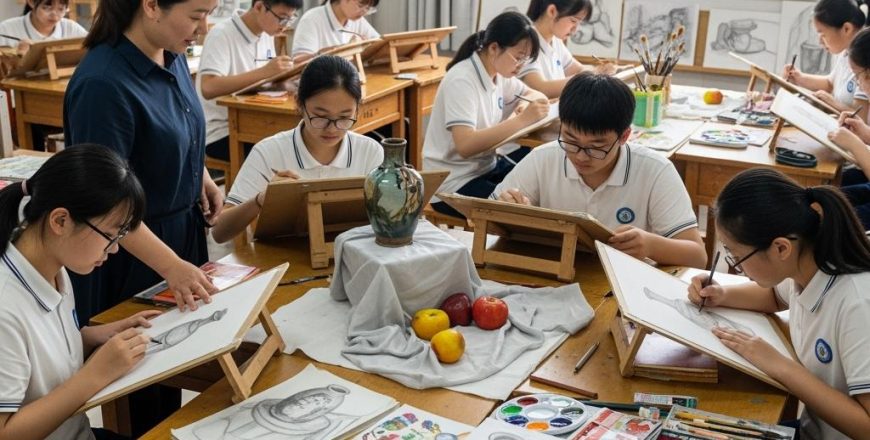- Description
- Curriculum
Sketching tutoring helps students develop drawing skills, enhance creativity, and build confidence in their artistic abilities through personalized guidance and practice.
Students will learn:
-
Line Symmetry: The property where one half of a shape is a mirror image of the other, used to create balanced designs.
-
Observation: The practice of closely examining subjects to capture accurate details in drawing.
-
Shading: The technique of adding varying degrees of darkness to create depth and dimension in artwork.
-
Observation & Shading: Combining careful observation with shading techniques to enhance realism in drawings.
-
Sketching: The act of quickly drawing to capture ideas, forms, and compositions, often as a preliminary step in the art-making process.
-
Isometric Drawing: A method of visually representing three-dimensional objects in two dimensions, maintaining scale and proportion without perspective distortion.
-
11. Line Symmetry Exercise7mins
To create a building using line symmetry, you can follow these steps:
-
Choose a Vertical Line of Symmetry: This could be the center of your paper. Draw a straight vertical line down the middle.
-
Draw One Side of the Building: Start by sketching one side of the building's facade. This can include windows, doors, and other architectural features. Make sure to keep the design simple for clarity.
-
Reflect the Design: Use the vertical line as a mirror. For every feature you draw on one side, create a symmetrical counterpart on the other side. For example, if you have a window on the left side, draw an identical window on the right side.
-
Add Details: Once both sides are complete, add details like a roof, chimneys, or decorative elements. Ensure these details are also symmetrical.
-
Finalize Your Drawing: Go over your lines to make them clear and bold. Erase any unnecessary guidelines, and you can color your building if desired.
-
-
22. Observation Exercise5mins
-
Grid Setup: Imagine the fish image is divided into 9 equal squares (3x3 grid). Each square represents a section of the fish.
-
Observation: Look closely at the fish in each grid section. Note the shape, curves, and key features (like fins and tail) that define its outline.
-
Tracing: Start tracing the outline of the fish by connecting the key points observed in each grid. Focus on maintaining the proportions and angles.
-
Final Touches: After tracing, refine your outline by smoothing out any jagged edges and ensuring that the overall shape resembles the original fish closely.
This exercise helps improve your observational skills and understanding of shapes!
-
-
33. Shading Exercise13 mins
-
Sketch the Outline: Start with a simple shape, like a sphere or a cube. Lightly sketch the outline of the object.
-
Identify the Light Source: Visualize the light coming from the top left. This means the top left side of your object will be the brightest.
-
Shading Technique:
- Highlight: Leave the area where the light hits the object (top left) lighter or white.
- Midtones: Gradually shade the areas that are partially illuminated. Use a pencil or shading tool to create a smooth transition from light to dark.
- Shadows: The areas opposite the light source (bottom right) will be darkest. Apply more pressure or use a darker pencil to create deeper shadows.
-
Blend: Use your finger or a blending tool to smooth out the transitions between light, midtones, and dark areas.
-
Refinement: Add details and texture to enhance realism, paying attention to how the light interacts with the surface.
This exercise will help you understand light and shadow, improving your overall drawing skills!
-
-
44. Observation + Shading Video10 mins
Observation Exercise
-
Shape: Begin by observing the overall shape of the apple. Note that it is generally round but may have slight irregularities.
-
Surface Features: Look for details such as:
- The stem at the top.
- Any dimples or blemishes on the surface.
- The curvature of the apple's sides.
-
Color Variation: Observe the color of the apple. It might have gradients, such as deeper reds or greens on one side and lighter shades on the other.
Shading Exercise
-
Outline: Lightly sketch the outline of the apple, capturing its round shape and stem.
-
Light Source: Decide on a light source. For this exercise, let’s assume the light is coming from the top left.
-
Shading Steps:
- Highlight: Leave the area where the light hits the apple (top left) lighter.
- Midtones: Shade the areas that are partially lit, creating a gradual transition from light to dark.
- Shadows: Focus on the bottom right of the apple, applying darker shading to indicate the shadow created by the apple’s curvature.
-
Blending: Use a blending tool or your finger to smooth the transitions between light, midtones, and shadows, making the apple appear more three-dimensional.
-
Final Details: Add texture by lightly shading the surface to represent the apple’s skin, and refine the shadow beneath the apple for depth.
This exercise will enhance your observational skills and understanding of light and form!
-
-
55. Sketching ExerciseVideo lesson
Step-by-Step Guide
-
Basic Shapes:
- Head: Start with a large circle for the head.
- Body: Draw an oval shape below the head for the body.
- Ears: Add two smaller circles on either side of the head for the ears.
-
Facial Features:
- Eyes: Inside the head circle, sketch two smaller circles for the eyes.
- Nose: Draw a small oval or circle in the center of the face for the nose.
- Mouth: Below the nose, add a curved line or a small circle for the mouth.
-
Limbs:
- Arms: Use elongated ovals to represent the arms, attaching them to the body.
- Legs: Draw two more ovals at the bottom for the legs.
-
Tail: Add a long, curved shape extending from the back of the body for the tail.
-
Refining: Once you have the basic shapes, start refining the outline by smoothing out the curves and connecting the shapes to form the monkey's limbs, facial features, and overall structure.
-
Details: Add details like fur texture, facial expressions, and any other features you want to highlight.
Final Touches
- Erase unnecessary lines from the basic shapes.
- Darken the finalized outline to give it definition.
- You can add shading or color to enhance your sketch further.
This method using round shapes will help you create a cute and simple representation of a monkey!
-
-
66. Isometric Drawing Exercise4mins
Objective: To practice isometric drawing by illustrating an object from three different perspectives: front, top, and side.
Instructions:
-
Materials Needed:
- Graph paper (preferably isometric grid paper)
- Pencil
- Eraser
- Ruler
-
Choose an Object: Select a simple geometric shape (like a cube or a rectangular prism) or a combination of shapes.
-
Draw the Front Perspective:
- Start by drawing the front view of your object.
- Use your ruler to ensure straight lines and maintain proportions.
-
Draw the Top Perspective:
- Move to the top view and draw the shape as it appears from above.
- Ensure that dimensions align with the front view.
-
Draw the Side Perspective:
- Finally, sketch the side view of the object.
- Again, keep dimensions consistent with the front and top views.
-
Review and Adjust:
- Compare all three views to ensure accuracy and coherence.
- Make adjustments as necessary for scale and alignment.
-
Add Details (Optional):
- Once you’re satisfied with the basic shapes, you can add details like texture, shading, or other features to enhance the drawing.
Tips:
- Keep your angles consistent (30 degrees for isometric).
- Lightly sketch before finalizing lines to make corrections easier.
- Practice with different objects to improve your skills in isometric drawing.
This exercise will help you understand how to represent three-dimensional objects in a two-dimensional format effectively.
-




